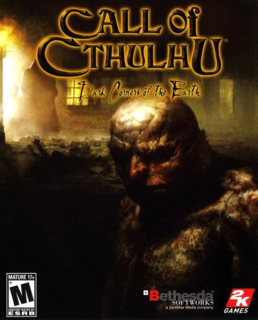H.P. Lovecraft would be proud.
The story to Dark Corners of the Earth is based on the H.P. Lovecraft story “The Shadow Over Innsmouth” but expands the story further. You play a detective by the name of Jack Walters, who is sent to Innsmouth to try and track down a missing store clerk, however once in the town you realize that there’s more at hand than a simple missing person. There are key events in the game that are ripped directly from the Lovecraft story, and fans should be pleasantly surprised with their inclusion.
The gameplay is very similar to Morrowind in terms of control, and seeing as how it’s in the hands of Bethesda that isn’t too surprising. The controls are boiled down to the bare minimum and navigating through the game is very simple, which when you’re fleeing for your life is appreciated. While the game is mostly comprised of exploration and simple puzzle solving, action is unavoidable. You do get an assortment of weapons to help you dispatch your unearthly foes, however the game is not centered around shooting and it lacks some of the refinements of more dedicated shooters.
There are 3 distinct gameplay elements that really stand out in Call of Cthulhu; Dynamic Sanity, lack of a HUD (heads up display IE life bar/ammo bar) and the Medical System.
The Sanity system plays a huge roll in the history of Call of Cthulhu, one could say that an expert on the Mythos of CoC would likely be a babbling, drooling lunatic. Essentially any time you witness an event that could be considered “unnerving” (such as mutilated corpses, supernatural beings and even physically straining activities such as maneuvering on high ledges) various effects will occur. These effects range from more traditional stress symptoms such as blurred vision to more threatening symptoms such as panic (which can cause involuntary movements) and even suicide. The longer you partake in “unnerving” situations the more your Sanity will be affected. These effects do wear off but they can be very hazardous when they’re taking place.
The lack of a HUD is something that adds to the immersion of the game. You’re able to interact in a world without constantly seeing their life and ammunition gauges, which can potentially knock them out of the game world. The game is extremely playable without a HUD and there are plenty of clues to your condition. If you take too much damage the color in the screen will slowly fade to black and while and your movement will slow down. Which brings us to the Medical System.
The Medical system is very similar to the system in Metal Gear Solid 3. Your character can take damage to various body parts and you must treat the wounds with bandages and sutures. You can either go into the inventory window and treat wounds manually, or your can hit the Quick Heal button which will automatically treat your injuries, assuming you have enough supplies. However healing isn’t instantaneous, Jack actually brings out a first-aid kit and treats the wounds, which can take upwards of 20 seconds if massively injured. If you take additional damage while healing the process is canceled. You also have the ability to take Morphine shots, however you can build dependency on the drug and it can cause greater Sanity problems in the future.
The games graphics provide a very realistic feel to the game world. Dark, drab colors cover the screen creating a look of severe dilapidation. The characters and monsters are very similar to what is described in the story and fit the overall graphic presentation very well. Small details such as insects, peeling wallpaper and cracked plaster add a whole other layer of immersion to the game. The sanity effects come across extremely well and are very believable, almost to the point of making me physically dizzy, which again simply adds to the immersion. While I think some graphical aspects could have been a little tighter (such as the look of the weapons) the overall quality and tone set a distinct visual mood.
In a game where immersion is the key, sound is very important. The sound in Call of Cthulhu is intimidating to say the least. While being pursued I was easily able to tell the location of my assailants and was able to hide or move accordingly. Great detail has been paid to the audio effects as well. Creaking doors/floor boards, breaking glass and even water drops fill the air. On top of natural sounds, the supernatural sounds certainly add an amount of dread to any situation. Ghostly voices, monstrous howls and half-human vocals greatly work against even the hardened gamers sanity.
Those elements combined make for a very powerful, solid gaming experience. This is a game that should not be passed up by any fans of horror or adventure. It’s a broad game that, at times, seems to stretch a little thin, however at it’s core is a fantastic story and an immersive world fit to be titled Call of Cthulhu.

